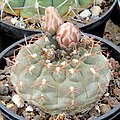
A cactus is a member of the plant family Cactaceae, a family of the order Caryophyllales comprising about 127 genera with some 1,750 known species. The word cactus derives, through Latin, from the Ancient Greek word κάκτος (káktos), a name originally used by Theophrastus for a spiny plant whose identity is now not certain. Cacti occur in a wide range of shapes and sizes. They are native to the Americas, ranging from Patagonia in the south to parts of western Canada in the north, with the exception of Rhipsalis baccifera, which is also found in Africa and Sri Lanka. Cacti are adapted to live in very dry environments, including the Atacama Desert, one of the driest places on Earth. Because of this, cacti show many adaptations to conserve water. For example, almost all cacti are succulents, meaning they have thickened, fleshy parts adapted to store water. Unlike many other succulents, the stem is the only part of most cacti where this vital process takes place. Most species of cacti have lost true leaves, retaining only spines, which are highly modified leaves. As well as defending against herbivores, spines help prevent water loss by reducing air flow close to the cactus and providing some shade. In the absence of true leaves, cacti's enlarged stems carry out photosynthesis.

Stapeliinae is a subtribe of flowering plants within the tribe Ceropegieae of the subfamily Asclepiadoideae of the family Apocynaceae. The subtribe comprises about 35 genera, including both the stem-succulent "stapeliads" and the horticulturally popular genera Brachystelma and Ceropegia. The largest number of genera are native to Africa, but a more limited number of genera are widespread in Arabia and Asia. Historically, a similarly circumscribed taxon was treated as a separate tribe, Stapelieae.

Echinocereus is a genus of ribbed, usually small to medium-sized, cylindrical shaped cacti, comprising about 70 species native to the southern United States and Mexico in very sunny, rocky places. Usually the flowers are large and the fruit edible.

Stetsonia coryne, the toothpick cactus, is the sole species in the cactus genus Stetsonia. Stetsonia coryne is native to arid regions of South America, where it grows to a height of 15 to 25 ft tall. It contains mescaline and other alkaloids.

Uebelmannia is genus of cacti, native to southeast Brazil. In a 2023 classification of the tribe Cereeae, it was placed as the only genus in the subtribe Uebelmanniinae, having formerly been placed in the subtribe Rebutiinae.

Parodia is a genus of flowering plants in the family Cactaceae, native to the eastern slopes of the Andes in northwestern Argentina and southwestern Bolivia and in the lowland pampas regions of northeastern Argentina, southern Brazil, eastern Paraguay, and Uruguay. This genus has about 65 species, many of which have been transferred from Eriocactus, Notocactus and Wigginsia. They range from small globose plants to 1 m (3 ft) tall columnar cacti. All are deeply ribbed and spiny, with single flowers at or near the crown. Some species produce offsets at the base. They are popular in cultivation, but must be grown indoors where temperatures fall below 10 °C (50 °F).

Espostoopsis is a monotypic genus of cactus containing the single species Espostoopsis dybowskii. The generic name is formed from Greek opsis meaning "view", referring to its resemblance to the genus Espostoa, with which it is often confused. The plant is only known from northern Bahia, Brazil.

Aylostera, is a genus of cactus, native to central Bolivia and north western Argentina. Aylostera was formerly sunk into a broadly circumscribed genus Rebutia, but molecular phylogenetic studies from 2007 onwards showed that when defined in this way, Rebutia was not monophyletic, leading to the resurrection of Aylostera. A 2023 classification of the tribe Cereeae placed it as the only genus in the subtribe Aylosterinae. It was formerly placed in the subtribe Rebutiinae.

Samaipaticereus is a monotypic genus of cactus containing the sole species Samaipaticereus corroanus. It is known only from East Andean Bolivia and Peru.

Trichocereinae is a subtribe of cactus that are particular to South America. There are 28 recognized genera in this subtribe.

Rhodocactus stenanthus is a species of cactus that is endemic to Brazil. First described as Pereskia stenantha, it was transferred to Rhodocactus in 2016. Like all species in the genus Rhodocactus, and unlike most cacti, it has persistent leaves. In its native locality, it is sometimes used in hedges.

Gymnocalycium saglionis, the giant chin cactus, is a globular cactus species endemic to northwest Argentina.

The Hylocereeae are a tribe of cacti. Most are found in the tropical forests of Central and northern South America, and are climbers or epiphytes, unlike most cacti. The tribe includes between six and eight genera in different circumscriptions. The plants known as "epiphyllum hybrids" or "epiphyllums", widely grown for their flowers, are hybrids of species within this tribe, particularly Disocactus, Pseudorhipsalis and Selenicereus, less often Epiphyllum, in spite of the common name.

Cereeae is a tribe of cacti belonging to the subfamily Cactoideae containing about 50 genera, divided in 2023 among six subtribes.

The Rebutiinae are a subtribe of cacti belonging to the subfamily Cactoideae, tribe Cereeae. A 2010 classification accepted seven or eight genera, but when circumscribed in this way, the subtribe was not monophyletic. A 2023 classification reduced Rebutiinae to three genera.

Gymnocalycium baldianum, the spider-cactus or dwarf chin cactus, is a species of flowering plant in the cactus family Cactaceae, native to the Catamarca Province in Argentina.

Gymnocalycium monvillei is a species of Gymnocalycium from Argentina.

Lobivia pentlandii, is a species of Lobivia found in Bolivia and Peru.

Gymnocalycium capillense is a species of Gymnocalycium cactus from Argentina.

Gymnocalycium uebelmannianum is a species of Gymnocalycium from Argentina.


































































